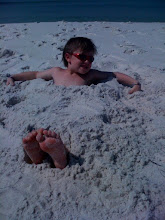My son has his first loose tooth. I saw it last night and broke into tears. My husband said, “You didn’t even cry this much when he started Kindergarten.” But Kindergarten was different. We knew the start of school nearly a year in advanced. We registered in the late spring, bought his backpack and new Keens, met his teacher and even went to orientation. As much as we could be, we were prepared for Kindergarten. I was not prepared for the loose tooth.
Sure, I had read loose teeth usually happen around age 6. But Truman doesn’t turn 6 for another three months. I thought we had more time. And I’ve grown rather attached to those tiny pearls, those slivers of white that hid inside his gums at birth and didn’t break through until he was four months old. They caused him to drool and fuss and drool and fuss. Despite that, I welcomed those little teeth. And now they are beginning their great departure.
Some research into the subject has taught me this – that my son may already have two adult teeth breaking the surface of his mouth. His 6-year molars should sprout behind his baby teeth in the back of his mouth sometime around age 6. This is all relative, because the rate at which a child loses his baby teeth and grows adult teeth is related to how early or late he started getting his baby teeth. If he was late in getting his baby teeth, he likely will be late in getting his adult teeth.
Baby teeth fall out in about the same order as they came in. The two front teeth on the bottom of the mouth are usually the first to go, followed by the two front teeth at the top. Most kids will lose their last baby tooth around age 12. And those wisdom teeth? Yeah, they usually drop in around age 17 and again at age 21.
Now, back to that first loose tooth. Truman knew he would eventually lose his teeth, like some of his friends have. But the loose tooth sort of took him by surprise. And it’s a little sore at times. Losing a tooth is a new experience for kids, so it can cause kids some anxiety. The online magazine Professor’s House offers these tips on how to get your child through that first loose tooth:
- Loose and permanent teeth just breaking the surface may be painful and may even bleed, which can be frightening for a young child. Reassure you child that the process is normal and a part of growing into a big boy or girl.
- If your child is in pain, consult your doctor or dentist about the best way to manage it. Sometimes a cold compress can handle the trick. (Remember teethers or frozen peas?) Your doctor or dentist may also suggest Tylenol or Motrin to get him over particularly painful episodes.
- Let your child wiggle that loose tooth, but encourage him not to pull a tooth (loose or otherwise) that isn’t ready to come out. Teeth that fall out on their own result in less bleeding and pain.
- And don’t forget to mention the Tooth Fairy, if she visits your house. Knowing that the Tooth Fairy will leave a reward for that tooth when it falls out should take the sting out of a sore tooth.
Photo, Flickr, dL76

No comments:
Post a Comment